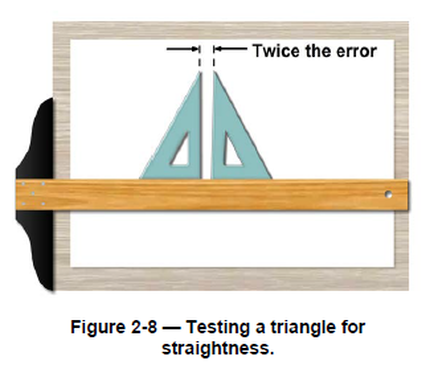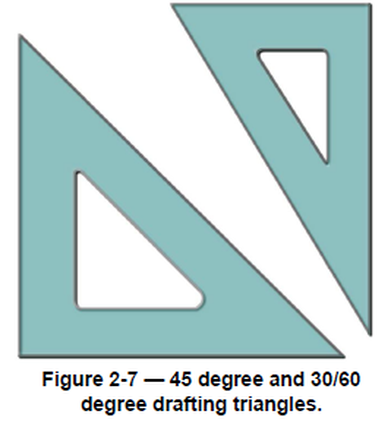
Triangles
Triangles are used in combination with the T-square or straightedge to draw vertical and inclined lines. They are usually made of transparent plastic, which allows you to see your work underneath the triangle. Triangles are referred to by the size of their acute angles. Two basic drafting triangles are illustrated in Figure 2-7: the 45 degree (each acute angle measures 45 degrees), and the 30/60 degree (one acute angle measures 30 degrees; the other, 60 degrees). The size of a 45 degree triangle is designated by the length of the sides that form the right angle (the sides are equal). The size of a 30/60 degree triangle is designated by the length of the longest side that forms the right angle. Sizes of both types of triangles range from 4 inches through 18 inches in 2 inch increments.
Like all other drafting equipment, triangles must be kept in good condition. If you drop a plastic triangle, you may damage its tip. Also, triangles may warp so that they do not lie flat on the drawing surface, or the edge may deviate from true straightness. To prevent warping or chipping, always lay them flat or hang them up when you are not using them. Since there is seldom enough drawing space available to permit laying triangles flat, develop the habit of hanging them up. If the tips are bent, use a sharp knife to cut off the damaged part. If the triangle is warped, you may be able to bend it back by hand. If bending does not straighten it, leave the triangle lying on a flat surface with weights on it or hold the triangle to the opposite curvature with weights. If the triangle becomes permanently warped, so that the drawing edges are curved or the angles are no longer true, throw it away and get another. To test the straightness of a triangle, place it against the T-square and draw a vertical line, as shown in Figure 2-8. Then reverse the triangle and draw another line along the same edge. If the triangle is straight, the two lines will coincide; if they do not, the error is half the resulting space.
Triangles are used in combination with the T-square or straightedge to draw vertical and inclined lines. They are usually made of transparent plastic, which allows you to see your work underneath the triangle. Triangles are referred to by the size of their acute angles. Two basic drafting triangles are illustrated in Figure 2-7: the 45 degree (each acute angle measures 45 degrees), and the 30/60 degree (one acute angle measures 30 degrees; the other, 60 degrees). The size of a 45 degree triangle is designated by the length of the sides that form the right angle (the sides are equal). The size of a 30/60 degree triangle is designated by the length of the longest side that forms the right angle. Sizes of both types of triangles range from 4 inches through 18 inches in 2 inch increments.
Like all other drafting equipment, triangles must be kept in good condition. If you drop a plastic triangle, you may damage its tip. Also, triangles may warp so that they do not lie flat on the drawing surface, or the edge may deviate from true straightness. To prevent warping or chipping, always lay them flat or hang them up when you are not using them. Since there is seldom enough drawing space available to permit laying triangles flat, develop the habit of hanging them up. If the tips are bent, use a sharp knife to cut off the damaged part. If the triangle is warped, you may be able to bend it back by hand. If bending does not straighten it, leave the triangle lying on a flat surface with weights on it or hold the triangle to the opposite curvature with weights. If the triangle becomes permanently warped, so that the drawing edges are curved or the angles are no longer true, throw it away and get another. To test the straightness of a triangle, place it against the T-square and draw a vertical line, as shown in Figure 2-8. Then reverse the triangle and draw another line along the same edge. If the triangle is straight, the two lines will coincide; if they do not, the error is half the resulting space.
